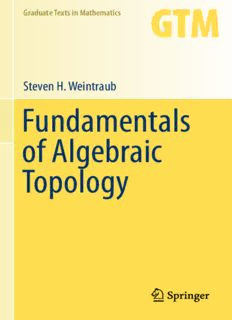
Fundamentals of algebraic topology PDF
Preview Fundamentals of algebraic topology
Graduate Texts in Mathematics Steven H. Weintraub Fundamentals of Algebraic Topology Graduate Texts in Mathematics 270 Graduate Texts in Mathematics SeriesEditors: SheldonAxler SanFranciscoStateUniversity,SanFrancisco,CA,USA KennethRibet UniversityofCalifornia,Berkeley,CA,USA AdvisoryBoard: ColinAdams,WilliamsCollege,Williamstown,MA,USA AlejandroAdem,UniversityofBritishColumbia,Vancouver,BC,Canada RuthCharney,BrandeisUniversity,Waltham,MA,USA IreneM.Gamba,TheUniversityofTexasatAustin,Austin,TX,USA RogerE.Howe,YaleUniversity,NewHaven,CT,USA DavidJerison,MassachusettsInstituteofTechnology,Cambridge,MA,USA JeffreyC.Lagarias,UniversityofMichigan,AnnArbor,MI,USA JillPipher,BrownUniversity,Providence,RI,USA FadilSantosa,UniversityofMinnesota,Minneapolis,MN,USA AmieWilkinson,UniversityofChicago,Chicago,IL,USA Graduate Texts in Mathematics bridge the gap between passive study and creative understanding, offering graduate-level introductions to advanced topics in mathematics. The volumes are carefully written as teaching aids and highlight characteristic features of the theory. Although these books are frequently used as textbooksingraduatecourses,theyarealsosuitableforindividualstudy. Moreinformationaboutthisseriesathttp://www.springer.com/series/136 Steven H. Weintraub Fundamentals of Algebraic Topology 123 StevenH.Weintraub DepartmentofMathematics LehighUniversity Bethlehem,PA,USA ISSN0072-5285 ISSN2197-5612(electronic) ISBN978-1-4939-1843-0 ISBN978-1-4939-1844-7(eBook) DOI10.1007/978-1-4939-1844-7 SpringerNewYorkHeidelbergDordrechtLondon LibraryofCongressControlNumber:2014949876 ©SpringerInternationalPublishingSwitzerland2014 Thisworkissubjecttocopyright.AllrightsarereservedbythePublisher,whetherthewholeorpartof thematerialisconcerned,specificallytherightsoftranslation,reprinting,reuseofillustrations,recitation, broadcasting,reproductiononmicrofilmsorinanyotherphysicalway,andtransmissionorinformation storageandretrieval,electronicadaptation,computersoftware,orbysimilarordissimilarmethodology nowknownorhereafterdeveloped.Exemptedfromthislegalreservationarebriefexcerptsinconnection with reviews or scholarly analysis or material supplied specifically for the purpose of being entered and executed on a computer system, for exclusive use by the purchaser of the work. Duplication of this publication or parts thereof is permitted only under the provisions of the Copyright Law of the Publisher’slocation,initscurrentversion,andpermissionforusemustalwaysbeobtainedfromSpringer. PermissionsforusemaybeobtainedthroughRightsLinkattheCopyrightClearanceCenter.Violations areliabletoprosecutionundertherespectiveCopyrightLaw. Theuseofgeneraldescriptivenames,registerednames,trademarks,servicemarks,etc.inthispublication doesnotimply,evenintheabsenceofaspecificstatement,thatsuchnamesareexemptfromtherelevant protectivelawsandregulationsandthereforefreeforgeneraluse. While the advice and information in this book are believed to be true and accurate at the date of publication,neithertheauthorsnortheeditorsnorthepublishercanacceptanylegalresponsibilityfor anyerrorsoromissionsthatmaybemade.Thepublishermakesnowarranty,expressorimplied,with respecttothematerialcontainedherein. Printedonacid-freepaper SpringerispartofSpringerScience+BusinessMedia(www.springer.com) Forinmuchwisdom ismuchgrief,andhe thatincreasesknowledgeincreases sorrow. Ecclesiastes1:18 Ofmakingmanybooksthereis noend, and muchstudyisa weariness oftheflesh. Ecclesiastes12:12 Preface The title of this book, Fundamentalsof Algebraic Topology, summarizes its aims verywell. Inwritingthisbookwehaveattemptedtoprovidethereaderwithaguidetothe fundamentalresultsofalgebraictopology,butwehavenotattemptedtoprovidean exhaustivetreatment. Our choice of topics is quite standard for an introductory book on algebraic topology,butadescriptionofourapproachisinorder. We begin with a short introductory chapter, with basic definitions. We assume the readeris alreadyfamiliar with basic notionsfrompoint-settopology,and take thoseforgrantedthroughoutthebook. WethendevoteChap.2tothefundamentalgroup,includingacarefuldiscussion ofcoveringspaces,vanKampen’stheorem,andanapplicationofalgebraictopology to obtain purely algebraic results on free groups. In general, algebraic topology involves the use of algebraic methods to obtain topological information, but this isoneinstanceinwhichthedirectionisreversed. We then move on to discuss homology and cohomology. Here we follow the axiomaticapproachpioneeredbyEilenbergandSteenrod.InChap.3weintroduce thefamousEilenberg-Steenrodaxioms.Indeed,inthischapterweconsiderarbitrary generalized homology theories and derive results that hold for all of them. Then, in Chap.4, we specialize to ordinary homology theory with integer coefficients, andderiveresultsandapplicationsinthissituation,stillproceedingaxiomatically. Of particular note are such important results as the Brouwer fixed point theorem andinvarianceof domain,which followfromthe existenceofa homologytheory, not from the details of its particular construction. Also of particular note is our introduction of CW complexes and our development of cellular homology, again fromtheaxioms. Of course,atsomepointwe mustshowthatahomologytheoryactuallyexists, and we do that in Chap.5, where we construct singular homology. We deal with thefullpanoplyhere–homology,cohomology,arbitrarycoefficients,theKünneth formula,products,andduality. Manifoldsareaparticularlyimportantclassoftopologicalspaces,andwedevote Chap.6totheirstudy. vii viii Preface Finally,inChap.7wegiveashortintroductiontohomotopytheory. Argumentsinalgebraictopologyinvolveamixtureofalgebraandtopology.But some arguments are purely algebraic, and, indeed, algebraic topology spawned a new branch of algebra, homological algebra, to deal with the algebraic issues it raised.Whileitisnotalwayspossibletocompletelyseparatethetopologyandthe algebra,inmanyinstancesitis.Inthoseinstances,wefinditadvantageoustodoso, as it better reveals the logical structure of the subject. Thus we have included the basicalgebraicconstructionsandresultsinanappendix,ratherthanmixingthemin withtherestofthetext. In our discussion of Poincaré duality on manifolds, we need some basic facts aboutbilinearforms,andwesummarizetheminasecondappendix. Algebraic topology also spawned the language of categories and functors. We havetendedto avoidthislanguageinthetext,asitismostly(thoughnotentirely) superfluousforourpurposeshere.Butitisilluminatinglanguage,andessentialfor students who wish to go further, and so we have included a third appendix that introducesit. Thereareseveralpointswewishtocallthereader’sattentionto.Thefirstisthat we have not felt compelled to give the proofsof all the theorems. To be sure, we give most of them (and leave a few of them as exercises for the reader), but we haveomittedsomethatareparticularlylongortechnical.Forexample,wehavenot provedvanKampen’stheorem,norhaveweprovedthatsingularhomologysatisfies the excision axiom. The second is that we have not always stated results in the maximumgenerality.Forexample,indevelopingproductsinhomologyandcoho- mologywe haverestrictedthepairsofspacesinvolved,andthecoefficientsofthe (co)homologygroups,tothesituationsinwhichtheyaremostoftenusedinpractice. Thethirdisthatwehavehewedtotheaxiomaticfoundationsofthesubject.Since its inceptionovera centuryago,algebraictopologyhasbuilta vastsuperstructure onthesefoundations,asuperstructurewehopethestudentwillgoontoinvestigate. Butwedonotinvestigateithere.Forexample,wesayverylittleabouttechniques forcomputinghomotopygroups. However,weprovideashortbibliographywherethereadercanfindthematerial we omit, as well as materialthat is beyondour scope. (In other words, the reader whowantstoseethis,orwantstostudyfurtherinalgebraictopology,shouldconsult thesebooks.) Our notationandnumberingschemehereareratherstandard,andthereislittle tobesaid.ButwedowanttopointoutthatweuseA⊆BtomeanthatAisasubset ofBandA⊂BtomeanthatAisapropersubsetofB. Lemmas, propositions, theorems, and corollaries are stated in italics, which clearlydelimitsthemfromthetextthatfollows.Similarly,proofsaredelimitedby thesymbol(cid:4)(cid:5)attheend.Butthereisusuallynothingtodelimitdefinitions,examples, andremarks,whicharestatedinroman.Weusethesymbol♦attheendofthesefor thatpurpose. Bethlehem,PA,USA StevenH.Weintraub October2013 Contents Preface............................................................................. vii 1 TheBasics..................................................................... 1 1.1 Background............................................................. 1 1.2 Homotopy............................................................... 2 1.3 Exercises................................................................ 4 2 TheFundamentalGroup.................................................... 5 2.1 DefinitionandBasicProperties........................................ 5 2.2 CoveringSpaces........................................................ 8 2.3 vanKampen’sTheoremandApplications ............................ 13 2.4 ApplicationstoFreeGroups........................................... 15 2.5 FreeHomotopyClasses................................................ 19 2.6 Some“Bad”Spaces.................................................... 20 2.7 Exercises................................................................ 21 3 GeneralizedHomologyTheory............................................. 23 3.1 TheEilenberg-SteenrodAxioms....................................... 23 3.2 ConsequencesoftheAxioms.......................................... 25 3.3 AxiomsforCohomologyandTheirConsequences................... 30 3.4 Exercises................................................................ 32 4 OrdinaryHomologyTheory................................................ 35 4.1 HomologyGroupsofSpheres,andSomeClassicalApplications ... 35 4.2 CW-ComplexesandCellularHomology.............................. 38 4.3 RealandComplexProjectiveSpaces.................................. 49 4.4 Exercises................................................................ 52 5 SingularHomologyTheory................................................. 55 5.1 DevelopmentoftheTheory............................................ 55 5.2 TheGeometricMeaningofH andH ................................ 61 0 1 5.3 HomologywithCoefficients........................................... 66 5.4 TheKünnethFormula.................................................. 69 ix
Description: